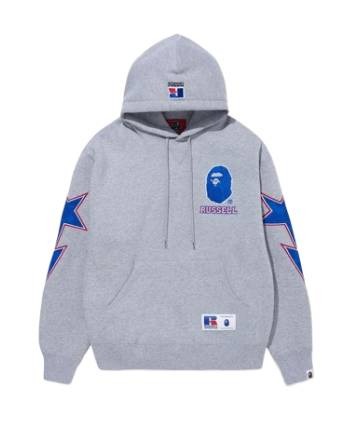Marvelous Bape Clothing – A Complete Guide to the Streetwear Giant

Introduction to Bape Clothing
When we talk about streetwear, one brand always makes it to the conversation—A Bathing Ape, or simply Bape. Founded in the heart of Tokyo’s fashion district, Bape Clothing is more than just clothing; it’s a lifestyle, a symbol of exclusivity, and a representation of urban cool. From its early days in Japan to becoming a global streetwear powerhouse, Bape has earned its place in the wardrobes of fashion lovers, sneakerheads, and celebrities alike.
Bape isn’t just about selling clothes—it’s about selling culture. Every drop feels like an event, every collaboration becomes a headline, and every hoodie or sneaker instantly turns into a collector’s item. Whether it’s the bold camouflage designs, the fierce Shark Hoodies, or the legendary collaborations with giants like Nike and Supreme, Bape has mastered the art of hype and creativity. But how did Bape come to be such a phenomenon? To understand the marvel that is Bape clothing, we need to take a step back and explore its origins.
The Origins of A Bathing Ape (Bape)
Bape was founded in 1993 by Nigo (Tomoaki Nagao), a Japanese DJ, record producer, and fashion visionary. Inspired by the vibrant Harajuku street culture, Nigo wanted to create something bold, disruptive, and unique. The name “A Bathing Ape” comes from the Japanese saying “a bathing ape in lukewarm water,” which refers to overindulgence—perfectly reflecting the playful, satirical edge of the brand. The brand’s early days were rooted in exclusivity. Nigo produced only a limited number of pieces, often just 30 to 50 items per design. These were sold at his store NOWHERE, co-founded with Jun Takahashi of Undercover. This scarcity-driven approach gave Bape instant cult status. If you wore Bape in the 90s, you weren’t just wearing clothes—you were signaling that you were part of an underground movement.
The designs themselves were unlike anything the world had seen before. Bright colors, cartoonish graphics, and bold logos became the identity of Bape. It stood apart from the minimalist and refined Japanese fashion trends of the time, appealing instead to a younger, rebellious crowd.
The Influence of Japanese Streetwear Culture
To truly appreciate Bape, one must understand the impact of Japanese streetwear culture in the 90s. Tokyo, especially Harajuku, became the epicenter of experimental fashion. Here, young people weren’t afraid to mix high-end pieces with thrift finds, or to embrace bold and unusual designs. Nigo tapped into this culture of experimentation. He infused Japanese creativity with influences from American hip-hop and skateboarding communities. The result? A brand that felt global but still uniquely Japanese. As Bape grew, it shaped not only Japan’s streetwear scene but also inspired countless brands worldwide. Many of today’s most popular streetwear labels owe their aesthetic and marketing strategies to the groundwork laid by Bape.
The Rise of Bape in Global Fashion
By the late 90s, Bape was no longer just a Japanese secret—it was making waves globally. The brand’s growing influence in hip-hop culture skyrocketed its popularity. Artists like Pharrell Williams, Kanye West, and The Notorious B.I.G. were spotted rocking Bape, instantly cementing its reputation as a must-have streetwear label. The early 2000s saw Bape release some of its most iconic products, including the Bapesta sneakers, which drew comparisons to Nike’s Air Force 1 but stood out with their glossy finishes and star-shaped logo. Celebrities embraced them, and they became a symbol of cool in the hip-hop community.
Bape also introduced the Shark Hoodie around this time, a piece that would go on to define streetwear fashion. With its zip-up design that covered the entire face and the sharp, aggressive shark motif, it was unlike any hoodie before it. It wasn’t just clothing; it was wearable art. The brand’s expansion into Europe and the U.S. solidified its status. By collaborating with international brands and opening flagship stores in fashion capitals like New York, Bape became a truly global phenomenon.
Signature Features of Bape Clothing
What makes Bape instantly recognizable? The brand has created some of the most distinct and iconic designs in fashion history. Let’s break down the signature features that set Bape apart from other streetwear brands:
The Iconic Bape Camo Design
Bape’s camouflage pattern isn’t your standard military camo—it’s vibrant, colorful, and filled with the brand’s signature Ape Head motif. The Bape camo comes in countless variations, from green and pink to neon and digitalized versions. Each variation feels fresh, but it always screams “Bape.”
The Famous Shark Hoodies
The Shark Hoodie is perhaps the most famous piece in the Bape catalog. With a zipper that extends up to the top of the hood, sharp teeth graphics, and bold lettering like “WGM” (World Gone Mad), it’s a true statement piece. Streetwear fans see it as a badge of honor, a piece that signals exclusivity and style.
The Ape Head Logo
Minimalist yet powerful, the Ape Head logo is central to Bape’s identity. It’s plastered on T-shirts, hoodies, sneakers, and accessories. The logo symbolizes rebellion and creativity—an emblem that fans proudly wear. Together, these features make Bape clothing not just apparel, but instantly recognizable fashion statements that resonate across cultures.
Popular Categories of Bape Clothing
Bape has grown into a full-fledged fashion empire, offering everything from sneakers to accessories. Here are the main categories that define Bape’s clothing line:
Bape Hoodies and Sweatshirts
The most sought-after items in Bape’s catalog. The Shark Hoodies, camo pullovers, and limited-edition prints make them collector’s items. Bape Hoodie They’re bold, colorful, and always a centerpiece in any outfit.
Bape T-Shirts and Casual Wear
Graphic tees featuring the Ape Head, Baby Milo characters, or bold slogans are everyday staples for Bape fans. They’re versatile pieces that can be styled with jeans, joggers, or layered under jackets.
Bape Sneakers and Footwear
The Bapesta is Bape’s crown jewel in footwear. With glossy finishes, wild colorways, and the signature star logo, they’ve become as iconic as any Nike or Adidas sneaker.
Bape Accessories (Hats, Bags, and More)
From snapback hats and backpacks to phone cases and even home goods, Bape knows how to extend its brand into every lifestyle product imaginable. These accessories add flair to any outfit and are highly collectible.
Collaborations That Made Bape Legendary
One of the key reasons Bape became a household name worldwide is its legendary collaborations. Unlike many fashion brands that keep their designs in-house, Bape thrives on teaming up with giants from across industries—sneakers, high fashion, entertainment, and even toys. These collaborations not only expand the brand’s reach but also cement its place in the culture of hype.
Bape x Nike and Adidas Partnerships
Back in the early 2000s, sneakerheads witnessed something revolutionary: Bapesta sneakers, which echoed the silhouette of Nike’s Air Force 1 but with a twist. Instead of the swoosh, Bapesta featured Bape’s star logo. The bold colorways and glossy finishes quickly became favorites among hip-hop artists and collectors. While this partnership was unofficial at first, it laid the foundation for Bape’s sneaker dominance. Adidas also recognized the power of Bape, teaming up to release camo-covered Superstars, NMDs, and Ultra Boosts. These sneakers sold out instantly, proving that when streetwear meets sportswear, the hype is unbeatable.
Bape x Supreme and Other Streetwear Giants
Few collaborations have stirred as much excitement as Bape x Supreme. Both brands dominate the streetwear space, and when they came together, fans couldn’t get enough. Limited-edition hoodies, tees, and accessories with blended logos became collector’s gold. Other noteworthy collabs include Bape x Stüssy, Bape x Undefeated, and Bape x Neighborhood—all of which strengthened its position in the streetwear hierarchy. Each partnership brought something fresh while staying true to Bape’s loud, playful style.
Celebrity Collaborations with Bape
From Pharrell Williams to Travis Scott, celebrities have long been associated with Bape. Pharrell’s Billionaire Boys Club even worked directly with Bape, creating crossover collections that are now highly sought-after. Other artists, including Kid Cudi and Kanye West, helped push Bape into mainstream culture. These celebrity endorsements aren’t just random partnerships—they create a cultural loop where fans see their idols wearing Bape and immediately want to cop it themselves. That’s how Bape went from Harajuku shops to global red carpets.
Why Bape Clothing Is So Expensive
It’s no secret that Bape comes with a hefty price tag. Hoodies often retail for hundreds of dollars, sneakers for even more, and rare collaborations can fetch thousands in resale markets. But why exactly is Bape so expensive?
The Exclusivity Factor
From its very beginnings, Bape has thrived on scarcity marketing. Founder Nigo intentionally produced small quantities, ensuring that demand always outweighed supply. This exclusivity made every drop feel special—owning a Bape piece meant you belonged to a select club. Even today, Bape releases items in limited drops, fueling hype and resell culture. Once something sells out, the only way to get it is through secondary markets at inflated prices.
Limited-Edition Drops and Hype Culture
Streetwear lives on hype, and Bape has mastered it. By teasing collections, collaborating with celebrities, and creating buzz around every launch, Bape ensures its fans are always eager to buy. This “fear of missing out” (FOMO) drives people to spend more, sometimes lining up overnight just to secure a piece. The resale market has only amplified this. A hoodie that retailed for $400 might resell for over $1,000, making Bape not just clothing but an investment for some.
Quality, Design, and Brand Value
Beyond hype, Bape delivers on quality. The fabrics are durable, the prints are bold, and the designs are unmistakable. Unlike fast fashion, where mass production rules, Bape prides itself on craftsmanship and originality. Add to that the cultural cachet of the brand, and you’re not just paying for clothes—you’re paying for status, history, and style. Owning Bape isn’t about need; it’s about belonging to a movement. Shop Now



